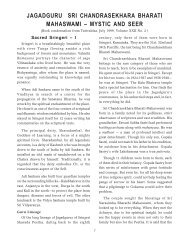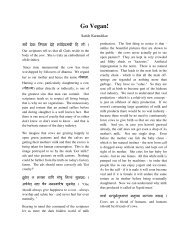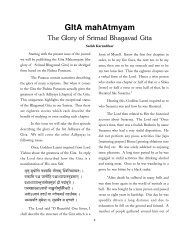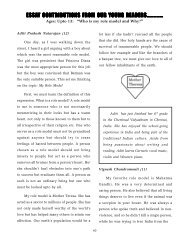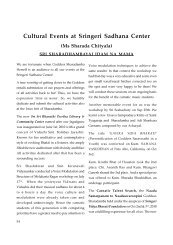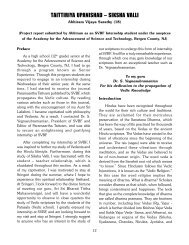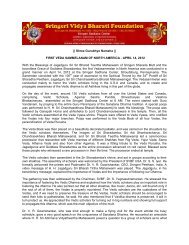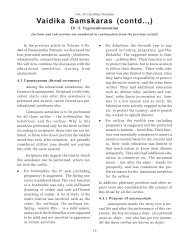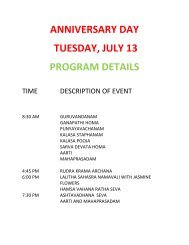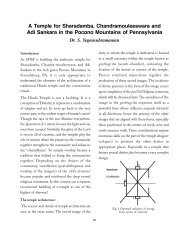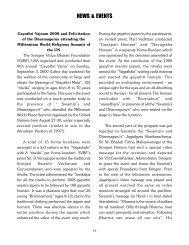Create successful ePaper yourself
Turn your PDF publications into a flip-book with our unique Google optimized e-Paper software.
Om, Sri Gurubhyo Namaha<br />
<strong>Vaidika</strong> <strong>Samskaras</strong> (<strong>contd</strong>..,)<br />
S. Yegnasubramanian<br />
(Sections and sub-sections are numbered in continuation from the previous article)<br />
In the previous article in Volume 5 No. 3&4 of<br />
Paramaartha Tattvam, we discussed one of the<br />
most important samskAras, the vivAha<br />
samskAra, which is the fourteenth samskAra of<br />
the forty-one samskAras mentioned in the first<br />
article of this series (Paramaartha tattvam, vol. 4<br />
No. 1, Jan-Mar 2002). We will continue the<br />
discussion with the rest of the samskAras in<br />
this article. All the discussions are based on<br />
tradition and scriptures; several of them are<br />
seldom in practice these days.<br />
The samskAras after vivAha are not popular<br />
today. As was noted earlier, the vivAha<br />
samskAra is the 14 th samskAra. There are 26<br />
more samskAras which are highly ritualistic.<br />
However, for the sake of completeness, we<br />
will outline them briefly in this article.<br />
The remaining 26 samskAras can be broadly<br />
classified in to four categories:<br />
1. panca-mahA-yajnas 5<br />
2. sapta-pAka-yajnas 7<br />
3. sapta-havir-yajnas 7<br />
4. sapta-soma-yajnas 7<br />
Total 26<br />
6. panca-mahA-yajnas : There is a nice sloka<br />
which gives all the five mahAyajnas.<br />
<br />
<br />
<br />
<br />
<br />
i. Learning in brahma-carya<br />
ASrama and teaching in grihastha –ASrama,<br />
to maintain the guru-Sishya paramparA, is<br />
prescribed. If cannot teach, one should<br />
perform a ritual at least, known as<br />
brahmayajna, which is a nitya karma.<br />
ii. Performance of tarpaNa<br />
during amAvAsya etc. occasions, to worship<br />
the ancestors.<br />
iii. - Offering oblations to devatas like<br />
Indra, agni, varuNa etc in hom, to express<br />
our gratitude to the natural forces and seek<br />
their blessings.<br />
iv. - bhUtayajna – or vaiSvadeva – to<br />
protect birds and animals.<br />
v. - Respect for other<br />
humans in society.<br />
PancamahAyajna is a very important samskAra<br />
for a grihastha.<br />
As mentioned above, three groups of seven<br />
yajnas each are also prescribed as part of the<br />
forty samskAras. All these are fire-rituals and<br />
are very seldom done these days. Before<br />
discussing these twenty one rituals, it is useful<br />
to understand a few details.<br />
During the vivAha samskAra, a particular fire<br />
ritual known as vivAha homa is performed.<br />
That vivAha-homa-agni is supposed to be<br />
preserved till a person dies or takes to<br />
sannyAsa. All the above mentioned 21 yajnas<br />
are to be performed in that agni alone. (At the<br />
time of sannyAsa, the person renounces all<br />
karma and gives up all agnis, and so is called<br />
nirAgni.)<br />
21
The grihastha is supposed to perform a nitya<br />
karma known as aupAsana, twice a day, in that<br />
agni (This ritual can be considered as a<br />
replacement of samidh AdhAnam.). The same<br />
agni is used for all the later samskAras of the<br />
children – upnayana, vivAha etc. – and other<br />
karmas, like SrAddha etc. When the son gets<br />
married, the father’s vivAha agni goes to the<br />
son, and so, is supposed to be maintained<br />
eternally.<br />
Since these agni samskAras are connected with<br />
the well being of the family, it is called grihya<br />
agni. This will vary from family to family; for<br />
example, for Rigvedis, it is prescribed by the<br />
AswalAyana grihya sutras; for yajurvedis, by the<br />
Apasthamba griya sutras; for sAmavedis, by the<br />
gobila griha sutras etc. These rituals are not<br />
given in Sruti (the Vedas), but prescribed by the<br />
Rishis in grihya sutras – from smritis. Since<br />
rituals prescribed in the smritis are performed<br />
in this agni, it is also called smArta agni, grihya<br />
agni, aupAsana agni etc.<br />
It is in this smArta agni, the first set of seven<br />
pAka yajnas are performed.<br />
7. sapta- pAka-yajnas :<br />
These involve the offering of cooked grains in<br />
the form of a gruel, and are done at different<br />
times, and frequencies:<br />
i. sthAlI pAkam – twice a month<br />
ii. pArvaNam - once a month<br />
iii. ashTakA – once a year<br />
iv. caitrI, - once a year<br />
v. AsvayajI – once a year<br />
vi. SrAvNI - 4 months in an year –<br />
(August to November).<br />
vi. AgrahAyaNI - conclusion of SrAvaNI<br />
once a year.<br />
Immediately after vivAha, the first of the seven<br />
pAkayajnas, namely, sthAlIpAka, is intitiated.<br />
As was mentioned earlier, the vivAha agni is<br />
also known as smArta agni. This agni is<br />
maintained in a circular kuNDa. A portion of<br />
this agni is taken to perform vedic rituals –<br />
srauta karmas – and is called srauta agni. The<br />
fourteen yajnas, namely the sapta-havir-yajnas<br />
and sapta-soma-yajnas, which are prescribed in<br />
the Vedas, are performed in the srauta agni,<br />
which should be preserved all the time.<br />
Elaborate procedures are given regarding the<br />
use of this agni for the performance of the 14<br />
rituals. The yAgSAla is also known as a<br />
“devayajna”. The kalpa-sutras contain a<br />
description of it, not omitting minute details.<br />
There are altars called “cayanas” to be built<br />
with bricks. (There are no cayanas for havir<br />
and pAkayajnas. ) Several kinds of ladles are<br />
used in making offerings in the fire, “tarvi”,<br />
“sruk” and “sruva” etc.<br />
The srauta agni is like the master of the griha –<br />
the grihapati - is supposed to protect from all<br />
calamities etc. and so is called the gArhapatya<br />
agni This is divided in to three, before the<br />
ritual. On the eastern side, a square kuNDa is<br />
established and a portion of the gArhapatya<br />
agni is transferred. There are prescriptions<br />
regarding the size of the kuNDa, the size of the<br />
bricks etc. This agni is called Ahavaneeya agni.<br />
On the southern side of the gArhapatya agni<br />
another kuNDa – semicircular in shape – is<br />
established. Another portion of fire from the<br />
gArhapatya agni is transferred to this kuNDA<br />
and is called dAkshiNAgni:<br />
srauta agni<br />
Ahavaneeya gArhapatya dAkshiNA<br />
agni agni agni<br />
22
Since the smArta agni is never divided, it is also<br />
called ekAgni, and, since the srauta agni is<br />
divided in to three, it is also called tretAgni.<br />
vi.<br />
nirUDha-paSubandha –The 6 th and the 7 th<br />
rituals are done in a very big scale,<br />
generally, once an year, outside the house.<br />
Most of the srauta rituals are done in the<br />
Ahavaneeya agni. No ritual is actually done in<br />
the gArhapatya agni and is only a witness. After<br />
the performance of the ritual, the Ahavaneeya<br />
agni and dAkshiNAgni are joined back in to<br />
gArhapatya agni.<br />
When a person dies, his cremation is<br />
performed using the srauta agni. The smArta<br />
agni is preserved for the wife. When the<br />
husband dies first, he will use up the srauta<br />
agni, and the smarta agni will be used to<br />
cremate the wife, which is supposed to give<br />
her svarga loka. If the wife dies first as a<br />
sumangali, part of the srauta agni will be used<br />
for her, which is believed to give her brahma<br />
loka. One should remember that these rituals<br />
are prescribed in the karma kANDa, only for<br />
those who are not jnAnis!<br />
8. sapta-havir-yajnas<br />
Thses are supposed to be performed in the<br />
Ahavaneeya agni. The seven yajnas are:<br />
i. agni AdhAnam - Division in to three; this<br />
division itself is a ritual; done only once. It<br />
has to be maintained. If it goes off,<br />
prAyascittam is to be done!<br />
ii. agnihotra – a daily ritual<br />
iii. darSa-pUrNa-mAsa performed twice a<br />
month – on amAvAsya and poorNimA days<br />
iv. AgrayaNa – once a year. - The above 4<br />
rituals are small rituals, done, mostly,<br />
within the house.<br />
v. cAturmAsya – different from what<br />
sannyAsIs observe. This ritual is performed<br />
three times in an year, once every four<br />
months.<br />
vii. sautrAmanI once a year. The last three<br />
haviryajnas - cAturmasya, nirudhapa-<br />
Subandha and sautrAmani - are performed<br />
in a yAgasAla.<br />
9. sapa-soma-yajnas<br />
In these yajnas, soma juice is offered with the<br />
chanting of sAma veda in high pitch. All are<br />
very big yajnas and are done outside the house,<br />
for the benefit of the entire country. The seven<br />
yajnas are:<br />
i. agnishtoma or jyotishtoma<br />
ii. atyagnishtoma<br />
iii. uktyam<br />
iv. shoDasI<br />
v. vAjapeya<br />
vi. atirAtra<br />
vii. AptoryAma<br />
It is generally observed that one does aupAsana<br />
and agnihotra daily, and the rest, at least once<br />
in a life time.<br />
During vivAha, the first smArta yajna, namely,<br />
sthAlI pAka, and the first srauta yajna, agni<br />
AdhAna are initiated. Among the 21 yajnas, the<br />
seven pAka yajnas are done in smArta agni and<br />
the remaining 14 are done in srauta agni, till<br />
death or till becoming a sannyAsI!<br />
As already mentioned, the daksiinAgni and the<br />
Ahavaniyaagni are made from the<br />
gArhapatyAgni. When srauta rites for the<br />
fathers have been performed in the<br />
dakhsinAgni and other srauta rites in the<br />
AhavaniyAgni, the two fires no longer have the<br />
exalted name of “srautAgni” and are just like<br />
any other ordinary fire and they have to be<br />
extinguished. Only the gArhapatya and<br />
23
aupAsana fires are to be kept burning<br />
throughout.<br />
On every prathama (first day of the lunar<br />
fortnight), a pAkayajna and a haviryajna have to<br />
be performed in the grhyAgni and srautagni<br />
respectively. The first is called sthAlipAka.<br />
“Sthali” is the pot in which rice is cooked and it<br />
must be placed on the aupasana fire and the<br />
rice called “caru” cooked in it must be offered<br />
in the same fire. The rite that is the basis of<br />
many others (the archetype or model) is called<br />
“prakrti”. Those performed after it, but with<br />
some changes, are known as “vikrti”. For the<br />
sarpabali called sravani and the pAkayajna<br />
called agrahayani, sthAlipaka is the prakrti.<br />
The haviryajna performed on every prathama is<br />
“darSa-pUrNa-ishTi”, “darSa” meaning the new<br />
moon and “pUrNa” the full moon. So the<br />
“ishTis” or sacrifices conducted on the day<br />
following the new moon and the full moon (the<br />
two prathamas) are together given the name of<br />
darSa-pUrNa-ishTi. The two rituals are also<br />
referred to merely as “ishTi”. This is the prakrti<br />
for haviryajnas.<br />
For soma sacrifices “agnistoma” is the prakrti,<br />
the word “stoma” also meaning a sacrifice.<br />
One who performs an elaborate sacrifice like a<br />
somayajna is called a “yajva”, “eeikshita” or<br />
“makhin”. And one who conducts the greatest<br />
of the somayajnas, vaajapeya, is known as a<br />
“vaajapeyin”. Sacrifices are called variously<br />
“kratu”, “makha”, “ishti”, “stoma”, “samsta”.<br />
There are some difference between these.<br />
The person who performs the yajna is called<br />
the yajamana and those who perform the<br />
sacrifice for him are called rtviks (priests) who<br />
consist of the hota (Rg veda priest), adhvaryu<br />
(yajurveda priest) udgAta (sAma veda priest) and<br />
brahmA (atharva veda priest)<br />
In pAkayajnas there are no rtviks; the<br />
householder (as the yajamAna) performs the<br />
rites with his wife. In haviryajnas there are four<br />
rtviks and the yajamAna. But the udgAta’s place<br />
is taken by the agnidhra. The udgAta is the one<br />
who sings the sAman. It is only in somayajnas<br />
that there is sAmagAna, not in haviryajnas. In<br />
cAturmasya and pasubandha there are more<br />
than the usual number of priests<br />
In somayajnas, there is the full complement of<br />
priests - the hota, the adhvaryu, the udgAta and<br />
the brahmA. Each priest is assisted by three<br />
others. So in all there are sixteen priests in a<br />
somayajna. agnistoma which is the first of the<br />
seven somayajnas is the prakrti (archetype) and<br />
the other six are its vikrti. These six are:<br />
atyagnistoma, uktya, soDasi, vaajapeya, atiraatra<br />
and AptoryAma.<br />
In the old days a Brahmin used all his wealth<br />
in performing the somayajna. Much of this was<br />
spent in dakshiNa to the priests and the rest for<br />
materials used in the sacrifice. There was also<br />
a time when even poor Brahmins performed<br />
this sacrifice every spring ( “ vasante vasante “)<br />
by begging! A Brahmin who conducted the<br />
sacrifice every year was thus called “prativasanta-somayAjin.<br />
10. Final samskAra – antyeshTi<br />
The final samskAra after death (obviously<br />
performed by the son or other near relative), is<br />
antyeshTi – antya ishTi –final yAga.<br />
The individual offered so many things during<br />
the 40 rituals all through the life. Finally, the<br />
body itself is offered to the agni.<br />
It is believed, that, after death, if the person<br />
has to get a better life in the next janma, the<br />
person should be purified of all sins and the<br />
fire does the purification.<br />
24
The cremation is not performed for sannyAsI,<br />
essentially for two reasons:<br />
i. At sannyAsa, the person has given up agni<br />
ii. the sannyAsa ASrama itself is a great fire of<br />
purification and so agni samskAra is not<br />
needed. If the person happens to be a<br />
jnAni also, there is no need for any<br />
samskAra – no question of reaching higher<br />
loka etc.<br />
<br />
For the three Asramas, dahanam etc. rituals are<br />
done; and<br />
<br />
for, sannyAsIs, nothing is to be done as<br />
samskAra;<br />
Not only that, there is no one need to do karma<br />
for him, and he never does karma to any one.<br />
<br />
Why? Because a jnAnI is akartA!<br />
All the samskAras are needed only when one<br />
depends on something or some body for<br />
purification. When the jnAnI himself or herself<br />
if pure, the jnAna agni will remove all<br />
impurities.<br />
From the hygiene point of view, cremation<br />
seems to be a good choice to destroy germs etc.<br />
which may affect others.<br />
At the time of death, the person is supposed to<br />
remember God. If cannot, others recite God’s<br />
names, Gita, Upanishad etc.<br />
Giving gifts – dAnam – is considered very<br />
noble and sacred; is done immediately after<br />
death, by others.<br />
Near the dead-body, certain rituals are<br />
performed, including a homa, as a prayer and<br />
for the safe journey of the subtle body. The son<br />
takes the srauta agni; the cremation ground is<br />
purified; there are rules regarding the type of<br />
wood; the body is bathed and new dress is put<br />
on – symbolic of leaving this body as a old<br />
cloth and taking on another body as a new<br />
cloth. Several mantras are recited for the<br />
various limbs to go back to the corresponding<br />
total divinities – the eyes will go back to the<br />
Sun God; the ears will go back to the<br />
directional deities etc. The day following<br />
cremation, the bones are collected –<br />
sancayanam karma- and thrown in to the river.<br />
An elaborate ritual lasting 13 days is<br />
performed. GaruDa purANa is recited so that<br />
the departed soul will be guided by the proper<br />
devatAs and reach the proper desitination.<br />
Rituals are performed for 12 days to develop<br />
various organs: For example,<br />
1 st day Development of body, head<br />
2 nd day sense organs, brain, etc<br />
10 th day Loses its preta status<br />
11 th day prayer for the well being of the<br />
jiva in the next janma<br />
12 th day the jiva to join the pitr loka<br />
- sapinDIkaraNam – the term<br />
piNDa (rice ball) symbolizes<br />
Sareeram– which is merged with<br />
the ancestors.<br />
If the person has done puNya<br />
himself or herself, he/she will<br />
attain good janma; if not, the<br />
rituals are supposed to enable<br />
getting one.<br />
13 th day forget the past; start with an<br />
auspicious note – Subham<br />
25
On the 13 th day, the asaucam (or uncleanliness)<br />
is believed to go away. There are essentially<br />
two aspects regarding asaucam:.<br />
1. From the medical stand point – germs etc.<br />
are likely to be with the intimate visitors,<br />
who are essentially close relatives; like a<br />
quarantine, the spreading is minimized.<br />
grihya sutras also give a lot of details.<br />
2. Mental shock and du:kham remain. With<br />
frustration and sorrow, a person will have<br />
only dislike and so is given time to get<br />
over that.<br />
However, there are some exceptions for<br />
asaucam – for example, brahmacarIs, sannyAsIs,<br />
and one, in the midst of an yAga, even if a<br />
grihastha, do not have asaucam.<br />
Our scriptures have prescribed these<br />
samskAras to facilitate a person to attain the<br />
eight great virtues – Atma guNas, which are:<br />
1. - Compassion, sensitivity to others etc.<br />
2. patience, forbearnce, capacity to face<br />
provoking situations without getting<br />
agitated<br />
3. absence of jealousy<br />
4. purity internally and externally<br />
absence of tension / anxiety<br />
6. absence of miserliness or<br />
helplessness<br />
7. absence of attachment<br />
8. auspiciousness / <br />
Absolute requires Atma-jnAnam. But one<br />
can get relative quietitude through the practice<br />
of these. When a person is endowed with the<br />
above AtmaguNas, he becomes an adhikArI –<br />
the eligible – for vedAnta and for the ultimate<br />
knowledge. Endowed with the Knowledge, the<br />
person has no worry about next life, krama<br />
muktI, svarga loka etc. Such a person is pUrNa:<br />
and lives with the awareness aham brahma<br />
asmi. Thus the samskAras lead to AtmaguNas<br />
which give adhikAritvam to gain Knowledge<br />
which gives liberation – moksha. If a person<br />
does not get the AtmaguNas in this life, with<br />
the antyeshTi samskAra, it is hoped that one<br />
will get them in the next life!!<br />
This concludes a cursory discussion of all the<br />
41 vaidika samskAras.<br />
Source Material:<br />
1. Hindu <strong>Samskaras</strong>, Rajbali Pandey, Motilal<br />
Banarasidas, Delhi, 1998.<br />
2. The Book of <strong>Samskaras</strong>, Prema Rasa Dasa,<br />
Bhakti Vedanta Book Trust International,<br />
1977.<br />
3. Lectures by Swami Paramarthananda,<br />
Madras.<br />
4. Hindu Dharma, Bharatiya Vidya Bhavan<br />
1995.<br />
26



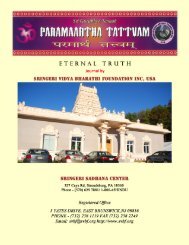
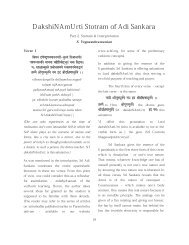
![Sri Venkatesha Karavalamba Stotram ô Ã;I ve±$ex kr;vlMb Sto]mà ô](https://img.yumpu.com/26953511/1/190x245/sri-venkatesha-karavalamba-stotram-a-ai-veaex-krvlmb-stoma-a.jpg?quality=85)
